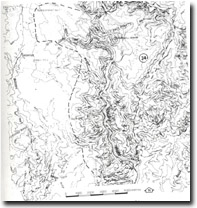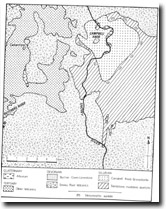8523-34 Campbell Knob/Tulloch Ard Gorge Section
8523 - 33 to 37 - Snowy River Gorge.
This information has been developed from the publications:
|
Location: | 199807 - 199710. The Snowy River Gorge between Campbell Knob and Bengal Jungle. | 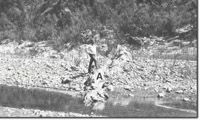 Snowy River at Campbell Knob. Quartz dyke (A). |
Abstract: | Variations in valley morphology associated with changes in lithology. | |
Access: | Campbell Knob Track and Museum Spur Track. | |
Ownership: | Crown land (including part of Snowy River National Park). | |
Geology: | Upper Silurian granitic rocks outcrop at Campbell Knob. These vary in texture from micro grained to coarse prophyrtic granites with phenocrysts up to two cm in diameter. In some places the granite contains a large percentage of hornblende and in the hand specimen resembles syenitic granite. It contains occasional large concentrations of xenoliths, is intensely jointed and is intruded by large quartz reefs and basic dykes. The reefs and dykes are prominent on Devils Backbone and in the Snowy River below Campbell Knob, and these are often associated with iron and copper sulphide mineralization. The Campbell Knob granite has intruded Silurian mudstones, sandstones and shale. Contact metamorphism of these sediments has resulted in the formation of quartzites and slates, the slates becoming increasingly schistose toward the granite contact. The metamorphic rocks are well exposed in the Snowy River channel downstream from Campbell Knob and in the contact ridge to the east of the Snowy River. To the north and south of the granite and Silurian sediments, Snowy River Volcanics are exposed in the Snowy River Gorge. Black Mountain Rhyodacite is prominent in the gorge sector to the north of Campbell Knob while the spectacular Tulloch Ard Gorge, to the south, is cut in Gelantipy Rhyodacite. The prominent plateau to the west of Campbell Knob is capped by Tertiary Older Basalt which forms the nick points for the small tributaries draining east to the Snowy River. Irregular drainage into small depressions on parts of this basalt surface has resulted in the formation of several small swampy lakes. | |
Geomorphology: | The Snowy River valley morphology varies in accordance with geological formations. Rapid down cutting by the Snowy River in rhyodacites has produced the deep Tulloch Ard Gorge. This contrasts with the relatively less precipitous valley morphologies occurring in the granite and Silurian sediments. The Campbell Knob granite is intensely fractured and this has facilitated weathering and erosion and results in low gradient valley side slopes, while the more resistant Silurian quartzites, sandstones and slates have produced steeper valley slopes. Of particular interest is Campbell Knob, as although it is composed of granite, it rises 600 m above the Snowy River channel with slopes comparable to that occurring in the Silurian sediments. Campbell Knob probably owes its relative relief to a cap of Snowy River Volcanics which protected the peak area while the unprotected surrounding granite was eroded away. Although the capping of volcanics has since disappeared from the peak itself, evidence of its former extent is provided by the small residual on the peak to the west of Campbell Knob. The wider lower gradient valley of the Snowy River in the granite rocks at Campbell Knob has allowed the deposition of sand and gravel bars and several small alluvial terraces. Such terraces are uncommon in the Snowy River Gorge. Metamorphism at the contact of the Campbell Knob granite and Silurian sediments has produced relatively resistant rocks and these form a prominent contact ridge on the eastern side of the Snowy River. | |
Significance: | National. Of particular significance is the variation in river valley morphology occurring in the Campbell Knob/Tulloch Ard section of the Snowy River Gorge. The rugged and precipitous topography of the Tulloch Ard Gorge cut in Snowy River Volcanics is in contrast to the relatively gentle valley side slopes cut in the Campbell Knob granite. | |
Management: | Construction of large reservoirs which would flood the Snowy River Gorge would destroy the scientific vale of the site. The spectacular scenic qualities could be seriously degraded by the removal of vegetation or the construction of artificial structures which would impinge upon the visual landscape of the area. | |
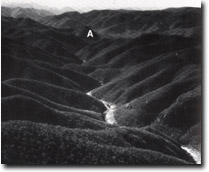 Tulloch Ard Gorge on the Snowy River. Campbell Knob (A). | 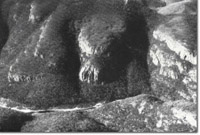 Southern section of the Tulloch Ard Gorge. |
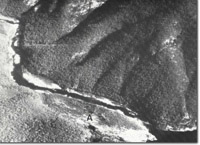 Alluvial terrace (A) in Snowy River near Cambell Knob. |

